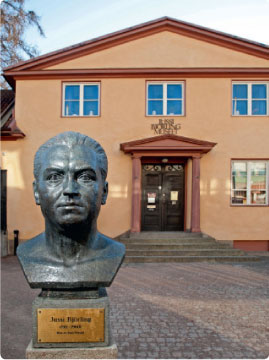Jussi of the Month April 2021
April 1952
Two recent “Jussi of the Month” discussed his many tours around the US, often in the company of pianist Frederick Schauwecker and sometimes also his wife Anna-Lisa. He exhibited his art of singing in concert programmes consisting of 15–20 songs and arias. In my article published in February 2021 I described how their contents may seem disparate but were very consciously shaped. Often they started out from some of the few more classical numbers in Jussi Björling’s repertoire – Handel, Mozart or Schubert, then through Richard Strauss or Rachmaninov reaching Nordic composers. Towards the end there were always some more popular American or Italian numbers. At suitable intervals the singer would introduce a few isolated opera arias, and at the very end there might also be some audience-pleasing aria or song by such as Paolo Tosti.
Recordings of five such complete recitals with piano exist which all have been on CD. They are not really true concerts of songs or “Liederabende”, rather a showcase for the art of the singer. But naturally there was an interest that Jussi should document also his repertoire of songs on records. Best-known is probably his concert at Carnegie Hall, New York, on 24 September 1955 which was promptly issued on LP (RCA LM-2003), somewhat abbreviated to fit onto one record. Later the whole recital has been issued on CD. Already in 1939 and 1940 Jussi recorded a few 78s with songs by Beethoven, Schubert, Brahms, Richard Strauss, Sibelius, Sjögren, Alfvén and Eklöf. His pianist then was Harry Ebert.
These discs represented a transition in Jussi’s gramophone career by being done partly in Stockholm for HMV, partly in New York for RCA Victor. These companies collaborated until 1957, and if we except his recordings twenty years earlier with the boys trio this was the first time Jussi Björling made gramophone records in USA. If war had not interrupted his US career there had likely been more. Starting with the famous duet recordings with Robert Merrill around New Year 1950/51 most of his recordings for the international market would take place either in New York or in Italy on behalf of RCA. Long Playing records had by now become a new factor. Already earlier, the American public could buy “albums” with several 78 rpm records, not just for longer works but also for portraits of one singer. So the step was short to collect several numbers onto an LP. For instance, those five duets with Merrill came out on a small (10-inch/25 cm) LP, as did a collection of arias recorded soon after in January 1951.
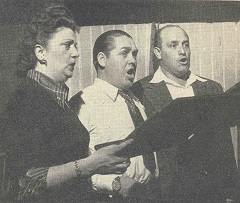
Jussi with Zinka Milanov and Leonard Warren during the recording of Il trovatore
collaborators. The last day of recording was 30 March. The other new venture was the LP Jussi Bjoerling in Song which this article is about.
April started with a few concerts in Washington, DC and elsewhere. On April 9 Jussi sang in Don Carlo at the Met, in a production we know from a live recording in 1950 when it was new. April 14 he sang a concert in Houston, Texas, and on the 18th he flew back to Sweden, where no performances are known until May 6. The recording of Bjoerling in Song took place in one day only, Friday April 11.
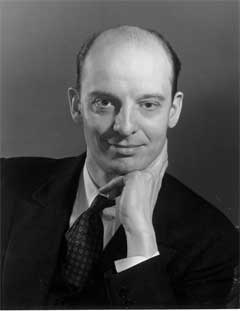
Frederick Schauwecker
with piano accompaniment during his tours. Here the order of the day is mostly Schubert and other German composers, plus one song by Rachmaninov that he does in English, a few Nordic songs and Tosti’s Ideale. As his favourites are not numerous a few are repeated from the 78s with Harry Ebert twelve years earlier.
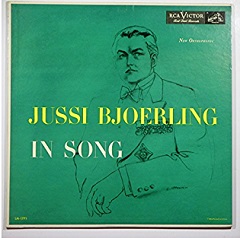
The cover of LM-1771
Click here to listen to "Die Forelle" from Jussi Bjoerling in song
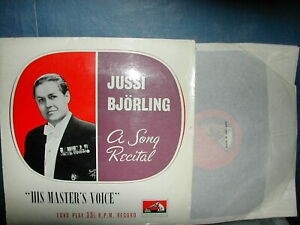
The HMV edition with a different cover and title.
German edition). When the two companies ceased collaborating in 1956–57 this HMV LP was withdrawn, and when RCA then started to sell records under its own name the company seems not to have regarded Bjoerling in Song worth reissuing. If you were truly interested it could be had on special order in American pressings, and in Sweden well-assorted shops carried it in their stocks. A few RCA subsidiaries on other continents also had local pressings in their catalogues.
In contrast to Il trovatore, Bjoerling in Song does not belong among his most widely sold records. People were more eager to hear the tenor in opera. In the US, RCA did keep it in their catalogues into the 1970s, when most mono discs had long been discontinued. I have seen it in the flimsy late ”Dynaflex” pressings RCA used at that time.
HMV was considerably later with LPs than RCA, and before ALP 1187 was released there were three 78s with a total of eight songs from LM-1171 for the European market. In both the US and Europe there were also some songs on 45 rpm extended play discs. But in none of these countries was it released in any of the many bargain series launched in the 1970s and 80s. It took until 2008 before the entire album became available on CD, then from Testament, one of the companies specializing in less easy-to-find recordings from the LP decades. It finally was included, obviously, in The Complete RCA Album Collection issued for Jussi’s centennial in 2011. Here the songs are properly presented in the same order as on the LP, although we cannot be entirely sure in which sequence they were recorded. In that box the green sleeve of the original RCA LP is reproduced. The simplest way of accessing its contents may however be as part of a CD in Naxos’s Björling edition (volume 5: 8.110789).
In both the complete RCA collection and Henrysson’s discography a separate matrix number is given for each song, all designated as first takes. They likely refer to the edited takes that were issued and archived, as recordings for some years had been on magnetic tape. But with only a day to record more than 49 minutes of music retakes and editing are unlikely. Björling and Schauwecker knew the music intimately after their extensive touring, the latest only the week before. RCA’s anonymous producer will not have interfered except to establish the aural image, and following an initial test this will not have had to be adjusted much. Jussi was used to microphones.
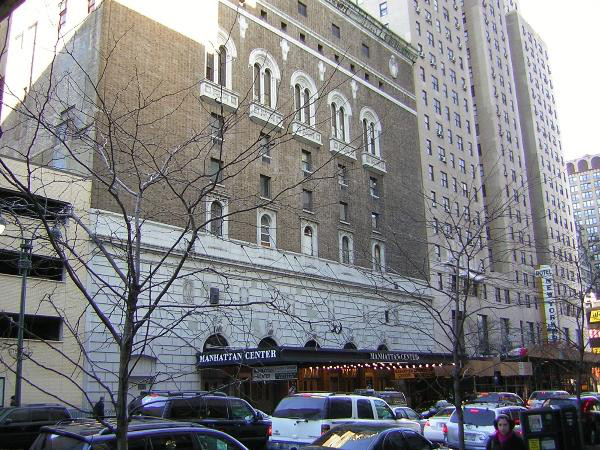
Manhatten Center today
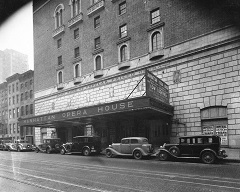
The name of the building remained in the late 20s
redone several times, to include among other things recording studios where many radio and TV productions were recorded. We may assume that Björling and Schauwecker worked in one of its smaller halls.
At this time RCA Victor had just launched high fidelity recordings named New Ortophonic Sound. Evidently they were proud of Bjoerling in Song and saw Jussi as one of their leading stars, because in 1954 one track from the album was included in an LP where tests for the buyer’s equipment alternate with specially written music by Robert Russell Bennett and selections from RCA’s classical catalogue (An Adventure in High Fidelity, LM-1802). Side by side with Jussi Björling’s A Dream (Grieg) we hear similar short excerpts from records by Roberta Peters, Victoria de los Angeles and Leonard Warren – all singers with whom he collaborated on other records. To reproduce songs like these is described in the LP booklet as ”one of the most searching and persuasive demonstrations of high fidelity’s power”, and the owner of the record is encouraged to experiment with the tone controls to realize how important treble and bass are for the experience.
Maybe we are not equally impressed almost sixty years later, but it mainly depends on which relation between voice and piano we desire. The record obviously documents vocal art for domestic consumption rather than a concert hall experience, and for most of us that may still be what we want. At least on a record we revisit for the sake of Jussi rather than Schubert. When it was released he was criticized in comparison with more specialized Lieder interpreters like newcomer Dietrich Fischer-Dieskau. But it was hardly the intention of RCA to compete. Perhaps we should do like Jussi Björling’s audiences, and interrupt after each song to applaud? There is little continuity from one song to next as to expression or vocal sound. Even if all were recorded in one day, I experience each song as separate from its context.
This was a difficult time in the Björling couple’s life. We read in the biography by Anna-Lisa (and Andrew Farkas) how she was near to divorce and psychological breakdown, and following the year’s initial performances in USA Jussi interrupted his touring and went home to Sweden for a few weeks in February–March. When he returned for, among other things, recording Il trovatore Anna-Lisa did not come with him, which is why she can quote several letters from her husband in her book. This is how Jussi wrote about his LP song recital which obviously was been planned just a few weeks in advance:
”RCA wants me to record a ‘Björling Concert’. There will be 10 to 12 songs, depending on their length. Naturally I will choose the ones both you and I like best. Isn’t that fun? The recording will take place on the 11th from 2 to 5 and 8 to 10, so I certainly have more than enough to do…”
“Recording RCA Björling Concert. 2:00–5:00 and 7:00–10:00 p.m. The recordings went brilliantly well. I sang 16 selections between 2:00–6:00. That has never been done before. I’m very satisfied.”
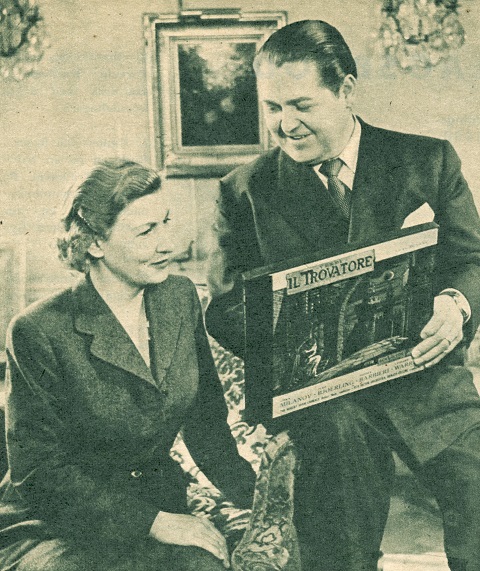
Jussi shows Anna-Lisa the album with the Il trovatore
If one listens carefully the close-up perspective of the microphone may reveal some phlegm on the vocal chords in one or two numbers, and although Jussi varies his dynamics he does not quite find his way back to the youthful ease of the versions of some of these songs that he recorded with Ebert twelve years previously. But the record is an impressive achievement and should be heard by every Jussi enthusiast.
Reviewers have often praised the 78 rpm-versions but been more lukewarm towards the LP. Some probably are critical to the idea of a programme where the songs are means for the singer to present himself, just like during his solo recitals around the US, rather than an exploration of a unifying idea with the songs or the poems in focus. This is a trade-off later artists also have grappled with in their LP or CD programmes, which nowadays usually have a more obvious theme than ”Bjoerling in Song” does.
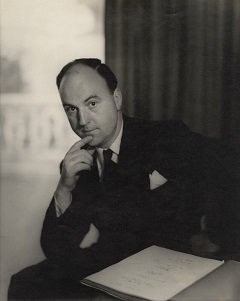
Philip Hope-Wallace
“If you already possess various of these songs sung by Hislop or Gerhardt or Elisabeth Schumann you may find these versions rather blunt, without enough subtlety or colour. But if you reflect on the usual assignations of this tenor, you will admit the collection shows a high standard of taste and musicianship, even if
not all the songs come over with that warmth which makes it seem an ideal performance. But the singing is good and the several languages …are well enough managed… What is a grave defect, however, in this sort of recital is an accompanist who acts merely as a sort of dumb waiter. It is extremely difficult to ‘get on with’ a song such as Die Mainacht or Strauss’s Morgen when the pianist is hanging fire all the time to see if the famous tenor would like to dwell a little longer on this note or that. The lack of a bracing rhythmic sense in the piano parts handicaps many of Mr. Björling’s best intentions. But the total effect is far from negligible.”
Click here to listen to "Die Mainacht" from Jussi Bjoerling in song
In November of the same year Jussi Björling recorded Tonerna and three other songs for HMV in London. Ivor Newton accompanied. All were in English, also Tonerna ("I bless ev'ry hour") which explains why it was repeated. These became his final studio recordings with just a piano. Later recordings of similar repertoire are all from live recitals with Schauwecker. I prefer these as they give me the feeling of being present in for instance Carnegie Hall, and Jussi’s way with art songs is often geared towards that kind of situation. Maybe this is a reason Bjoerling in Song does not get played as often as other Jussi discs. Even a connoisseur like Stephen Hastings is however impressed by several among the songs on it. In his The Björling Sound he devotes an entire page to Die Mainacht which Gramophone’s reviewer was less satisfied with. When he wrote his book this was the only version of the song by Jussi Björling that was known; now it has been joined by the Copenhagen recital of 1959 where he also sang this song by Brahms, so comparisons are possible. Hastings compares with more specialized lieder singer and praises the tempo. Björling’s version is described as ”something of a revelation”.
So there is every reason occasionally to take out the results from that day of hard work 11 April 1952. Particularly remarkable is that so much was achieved in just one day!
Nils-Göran Olve
Click here for Jussi of the Month Summary




